Samsung Galaxy S III Performance Preview: It's Fast
by Brian Klug & Anand Lal Shimpi on May 3, 2012 6:13 PM EST- Posted in
- Smartphones
- Samsung
- Mobile
- SoCs
- Exynos 4 Quad
- Galaxy S III
Earlier today Samsung unveiled its Galaxy S III, at the heart of which is Samsung's new Exynos 4 Quad SoC. Fortunately we got a ton of hands on time with the device at Samsung's unpacked event in London and are able to bring you a full performance preview of the new flagship, due to be shipping in Europe on May 29th.
The Exynos 4 Quad is an obvious evolution of the dual-core Exynos in many of the Galaxy S II devices. Built on Samsung's 32nm high-k + metal gate LP process, the new Exynos integrates four ARM Cortex A9s running at up to 1.4GHz (200MHz minimum clock). Each core can be power gated individually to prevent the extra cores from being a power burden in normal usage. Each core also operates on its own voltage and frequency plane, taking a page from Qualcomm's philosophies on clocking. There is no fifth companion core, but the assumption is Samsung's 32nm HK+MG LP process should have good enough leakage characteristics to reduce the need for such a design.
The GPU is still ARM's Mali-400/MP4, however we're not sure of its clocks. Similar to the dual-core Exynos, there's a dual-channel LPDDR2 memory controller that feeds the entire SoC. The combination should result in performance competitive with NVIDIA's Tegra 3 (and a bit higher in memory bandwidth limited scenarios), but potentially at lower power levels thanks to Samsung's 32nm process.
While we won't know much about the power side of things until we get a review device in hand, we can look at its performance today.
Browser & CPU Performance: Very Good
As always, we start with our Javascript performance tests that measure a combination of the hardware's performance in addition to the software on the device itself. Sunspider performance is extremely good:
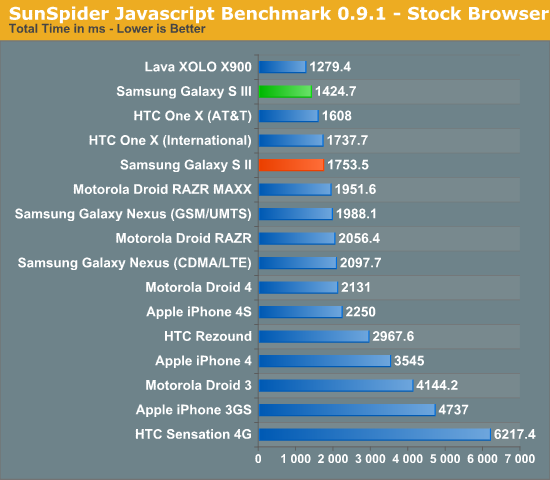
While we thought we hit a performance wall around 1800ms, the One X from HTC, the Lava XOLO and now the Samsung Galaxy S III have reset the barrier for us. In this case the performance boost is likely more due to software than hardware, but the combination of the two results in performance that's better than almost anything we've seen thus far. The obvious exception being Intel's Medfield in the X900.
BrowserMark is another solid js benchmark, but here we're really able to see just how much tuning Samsung has done in its browser:
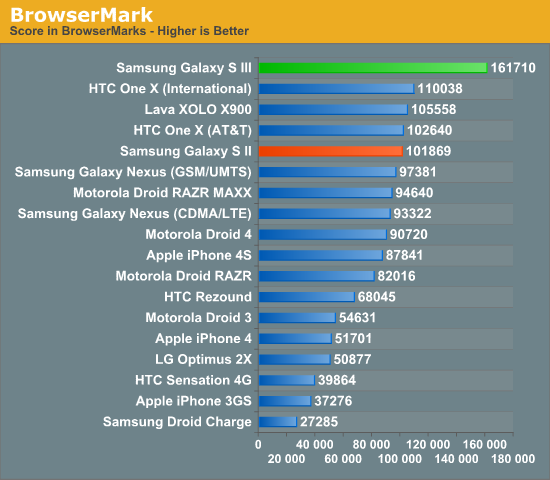
The Galaxy S III is significantly faster than anything else we've ever tested thus far. The browsing experience in general is very good on the SGS3, and the advantage here likely has more to do with Samsung's browser code and the fact that it's running Android 4.0.4 rather than any inherent SoC advantage. We know how 1.4GHz Cortex A9s should perform, and this is clearly much better than that.
Once again we turn to Qualcomm's Vellamo to get an idea for browser and UI scrolling performance:

Although (understandably) not as quick as the Snapdragon S4 based One X, the SGS3 does extremely well here - likely due in no small part to whatever browser optimizations ship in Samsung's 4.0.4 build. As Brian put it when he first got time with the device: it's butter.
GPU Performance: Insanely Fast
While we don't know the clocks of the Mali-400/MP4 GPU in the SGS3, it's obviously significantly quicker than its predecessor. Similar to what we saw when the Galaxy S II launched, Samsung once again takes the crown for fastest smartphone GPU in our performance tests.
The onscreen GLBenchmark Egypt and Pro results are understandably v-sync limited, but if you look at how much headroom is available thanks to the faster GPU it's clear that the Galaxy S III should be able to handle newer, more complex games, better than its predecessor.
What's particularly insane is that Samsung is able to deliver better performance than the iPhone 4S, the previous king-of-the-GPU-hill in these tests.
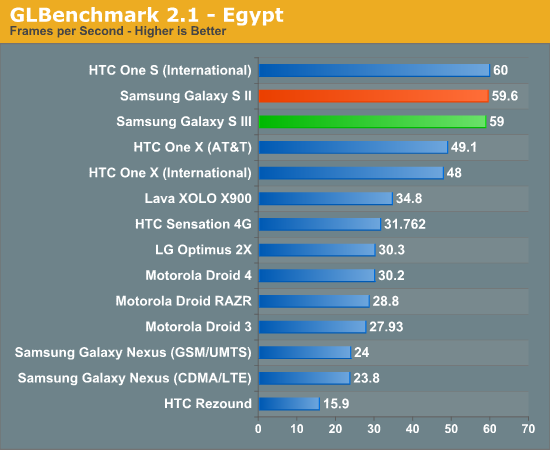
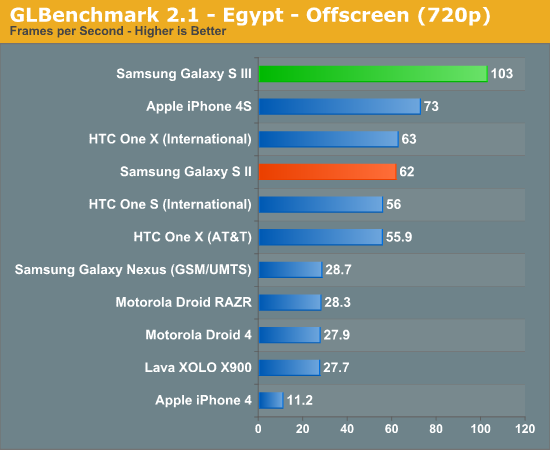
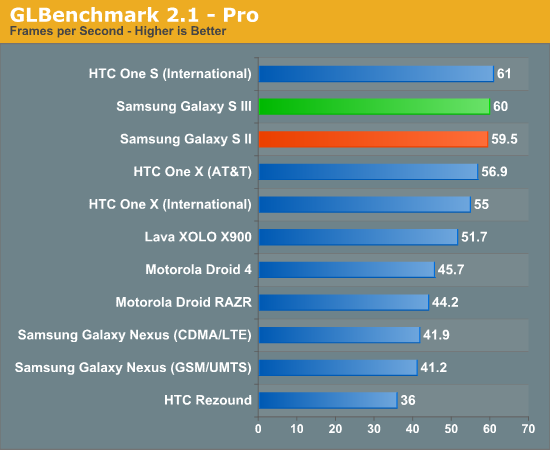
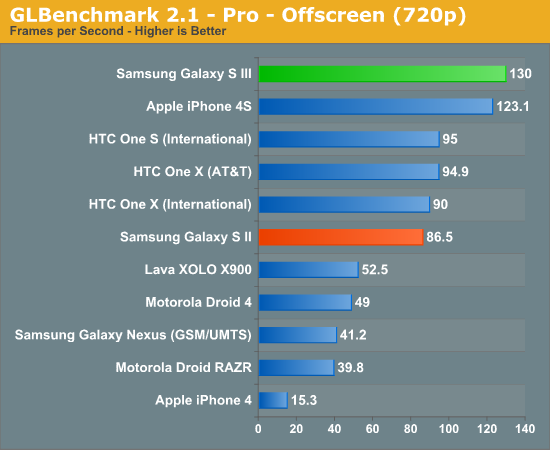
The performance advantage isn't anywhere near as staggering if we look as BaseMark ES 2.0, however as we've mentioned before this benchmark is definitely showing its age at this point. Despite the aggressive tuning Qualcomm has done for these benchmarks, Samsung is actually able to remain competitive and even pull out a slight win in the Taiji test. Both benchmarks are v-sync limited on the fastest platforms however.
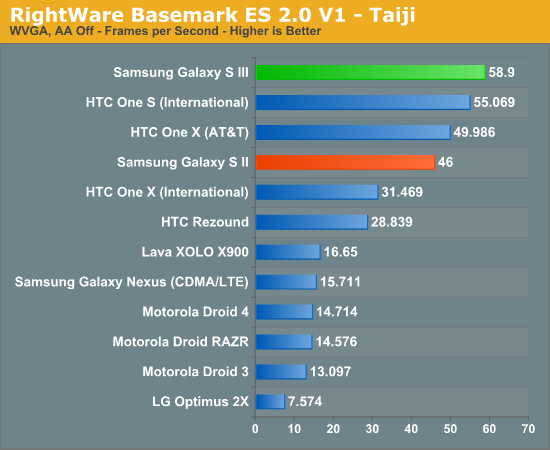
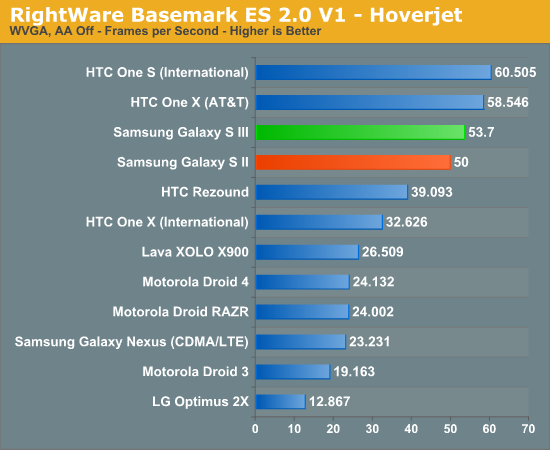
Final Words
Our first interactions with Samsung's Exynos 4 Quad are promising, but there's still much more to understand. Samsung clearly used 32nm as a means to higher GPU clock speeds, which in turn gives us much better GPU performance. The big unknown, as always, is power consumption. Based on what we've seen thus far from Samsung's 32nm LP process in Apple's iPad 2,4 (review forthcoming), Exynos 4 Quad should be a pretty good step forward in the power department as well.
As soon as we can get our hands on final hardware you can expect a full review of the Galaxy S III, including power and battery life analysis.
Initial reactions to the Galaxy S III announcement seemed almost disappointing, however stay tuned for our hands on impressions of the device as well as even more depth/detail on the hardware platform - you may be surprised.















92 Comments
View All Comments
steven75 - Sunday, May 6, 2012 - link
You must have some massive pockets and/or never sit down with your phone in your pocket. I'll point out that the majority of people do not remove their phone from their pocket while sitting or walking because it's already comfortable.steven75 - Sunday, May 6, 2012 - link
"Theres a reason nearly all other phones are using larger screens - because they're better!"More like because they need a reason to differentiate from Apple and fit larger larger batteries to handle the OS with the most inefficient power usage.
In the US Apple sells more iPhone on each carrier it's on that all Android phones on the same carrier combined. If the display size was an huge problem, that wouldn't happen.
Aenean144 - Friday, May 4, 2012 - link
An A5X from Samsung's 32 nm node will be about 95 mm^2. This would be about 25% smaller than the current A5 (~124 mm^2) in the iPhone 4S. With a 20% savings in power as well, it'll be about the same power envelope.Apple has prioritized GPU over CPU when they have these constrained situations. At least GPU of a certain baseline. You can make the call right now that the dual-core A9 in the 2012 iPhone will be no more than 1 GHz.
steven75 - Sunday, May 6, 2012 - link
iFad...really? Are you 12?jamisont - Friday, May 4, 2012 - link
perfect example would be 45nm A5 on Ipad 2 vs 32nm A5 on new Ipad.. similar performance but better battery life.aliasfox - Friday, May 4, 2012 - link
If Apple can't get a new chip out in time (A15 based A6 or something), my bet would be something along the lines of a die shrunk, 32nm A5 with a ~50% speed bump. Remember, A5 in the iPhone runs at 800 MHz, so even a 50% speed bump would only bring it to 1.2 GHz.If we were to scale the iPhone 4s benchmarks presented here by 50%, the new scores would be fairly comparable to the GS3 on the graphics front and not be too far behind on the browser side of things.
I guess it would be interesting to see what they have to do to bring 2012 levels of SoC performance and LTE while maintaining some semblance of battery life without increasing the phone to the size of a small tablet - we all know that the reason everyone else's 'flagship' phones are 4.5"+ is because it provides more room for a battery, and this is something Apple's been keen to avoid so far.
zorxd - Friday, May 4, 2012 - link
Browser benchmarks are not CPU benchmarks. Unless you compare two phones with the exact same version of the browser.Apple's A5's CPU (or A5X, it's the same) is no faster than any other Cortex A9.
A 1.2 GHz A5 would have a CPU comparable to the Galaxy S2, so it would still be 2011 levels of performance.
Apple skipped the CPU upgrade the last time, so I believe this time they will show something much more powerful. They might have a quad core A9 too, a dual A15, or at the bare minimum, a high frequency dual A9.
Aenean144 - Friday, May 4, 2012 - link
I really doubt that Apple will have a Cortex-A15 SoC for the 2012 iPhone.There's only two possibilities: a 32 nm A5X or a 32 nm A5. If it is a 32 nm A5X, it'll be no more than 1 GHz. If it is a 32 nm A5, it'll be 1 GHz, maybe 1.2 GHz.
Both options will be competitive to the Galaxy S3. For 95%, maybe 99%, of a consumer's workload, dual-core will be perfectly fine, if not overkill. Quad-core is overkill. 95% of the software out there are either single threaded or only has one thread that really requires CPU power.
With the A5X in an iPhone, Apple is giving up the 5% of folks who would use software that is embarrassingly parallel such as computational modeling, in favor for higher performance in gaming or anything that can use the GPU. With games being the dominant app in the app store, it is certainly the right choice.
krumme - Thursday, May 3, 2012 - link
I was i doubt about the effect of pentile, but then re-read this january article about the nexus display:http://www.anandtech.com/show/5310/samsung-galaxy-...
Now this is damn solid reviewing, comparing different own measuring and calculation technique with own subjective experience. Looking forward for another detailed, solid, phone review. The effects of battery life is of outmost importance to me, or else i will have to cancel my preorder.
Btw glad we didnt get some fancy material, with a nice marketing name, only to be shattered in real life. We want flexible plastic :)
steven75 - Sunday, May 6, 2012 - link
"Btw glad we didnt get some fancy material, with a nice marketing name, only to be shattered in real life. We want flexible plastic :)"It's too bad they didn't make a nice looking plastic phone like the One X or Lumia 900 and instead had to make something that looks like a 2008 design.